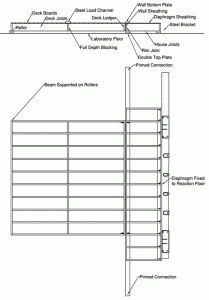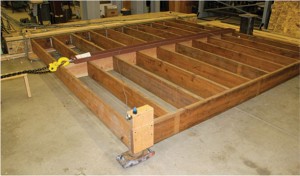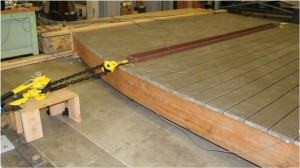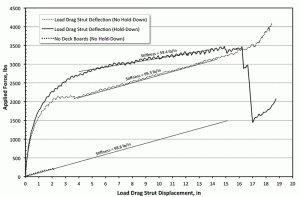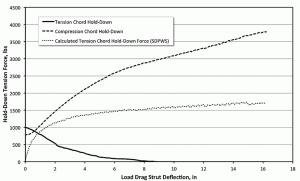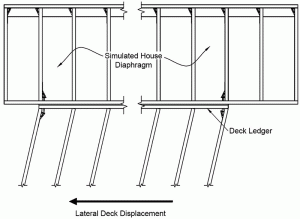Safety of exterior elevated decks, balconies and porches continues to be an important national issue. Section 1604.8.3 of the 2009 International Building Code (IBC) states that decks shall be anchored to the primary structure and designed for both vertical and lateral loads. The focus of this article is to address knowledge gaps on the performance of decks subjected to lateral loading.
The information presented here builds on earlier works dealing with lateral loading on decks from wind, seismic and occupants (Lyman and Bender 2013; Lyman et al. 2013; Parsons et al. 2013). Armed with a better understanding of lateral loads, this article targets load transfer from decks to the main structure floor framing and diaphragm. Two 12-foot x 12-foot decks were connected to a portion of a light-frame wood diaphragm to simulate realistic support conditions. Lateral loads were applied to these decks with and without tension hold-down connectors, in accordance with a prescriptive detail that was introduced in the 2009 International Residential Code (IRC) (Figure 502.2.2.3). Load paths were characterized by instrumenting each lag screw and tension hold-down connector. The study yielded counterintuitive results that will help guide new design solutions and products to resist lateral loads.
Materials and Deck/Diaphragm Construction
Two 12-foot x 12-foot decks were constructed using similar materials. One deck was constructed with a tension hold-down at two corners and the other had no hold-downs. The decks were built in accordance with Design for Code Acceptance 6 (DCA 6), which follows the 2009 IRC. The deck ledger was a 12-foot-long 2×10 with 2×10 joists spaced at 16 inches on center. The deck boards were wood-plastic composite (nominal 1×6) Trex Accents. All lumber used for the deck joists and ledger was incised and pressure preservative treated (PPT), No. 2 and Better Hem-Fir. Details on the deck construction and testing were reported in Parsons (2012).
The simulated house diaphragm assembly was constructed in accordance with the 2009 IRC and the Wood Frame Construction Manual (AF&PA 2001). The sheathing (23/32-inch nominal thickness) was glued and nailed to the joists using construction adhesive designed for subfloor and deck applications. The nails were 2.5 inches by 0.131 inches and fastened the sheathing to the joists per IRC Table R602.3. When hold-downs were used, nails were spaced 6 inches on the diaphragm joist with the hold-down attached. Figure 1 shows the elevation and plan views of the test set-up.
The deck ledger was attached with lag screws that had 0.5-inch diameter full body, a length of 7 inches (to accommodate the load cell) and a root diameter of approximately 0.370 inches. Lag screws were installed 15 inches on center in a staggered pattern as specified in IRC Table R502.2.2.1.
Deck joist hangers proved to be a weak link in the lateral load path, and deserve special attention (See the sidebar at the end of this article.)
The hold-down connectors used on the second deck configuration were Simpson Strong-Tie (SST) DTT2Z with a “ZMAX” protective coating. The hold-down was 14-gauge steel and a 0.5-inch diameter threaded rod was used to connect the hold-downs from the deck to the house. The 0.25-inch x 1.5-inch screws used with the hold-down were SST Strong-Drive screws (Model No. SDS25112) that had a double-barrier coating with equivalent corrosion resistance to hot-dip galvanized.
Test Methods
Lateral loading was applied as a resultant line load acting through the centroid of the deck surface. Since large displacements were anticipated, force was applied with a come-along as shown in Figure 2. A 10 kip load cell was installed in-line with the come-along to record the force applied to the deck.
A conservative assumption was made that the deck substructure would provide minimal lateral resistance; therefore, the deck was supported on rollers along the outer beam. The simulated house diaphragm was securely anchored to the laboratory reaction floor.
Load cells were used to record forces in all lag screws connecting the deck ledger to the diaphragm rimboard and hold-downs. Seven string potentiometers were used to measure deck displacements.
Results and Discussion
Observed Damage
Moment couples formed by two screws in each deck board-to-deck joist connection provided the lateral stiffness of the deck diaphragm. In both tests, splitting of the top edges of the deck joists was the main source of damage, caused by the moment couple from the deck screws that induced stresses perpendicular to the grain. Each deck joist was completely split to the depth of screw penetration from the load drag strut to the ledger board. Significant yielding and fracture of deck board screws was also observed in this same region. In both tests, no damage was observed in the deck ledger-to-house rimboard connection or in the simulated house diaphragm.
In the test that used hold-down tension connectors, deck joists fractured in weak axis bending. This was due to the hold-down installed on the compression chord producing larger rotational joist stiffness at the ledger connection than the joist hangers provided on the other joists. This caused load from the other deck joists to be attracted to the end joist, resulting in fracture. Once the end joist fractured, the remaining joists fractured due to progressive failure.
Load-Displacement Curves
For the test with no hold-down, the load displacement curve at the load drag strut, shown in Figure 3, can be divided into three segments. The first segment was a softening curve that is seen in tests of many mechanically connected structural assemblies as slip occurs and damage initiates. At a displacement of approximately 3.5 inches, significant joist splitting had occurred and most of the diaphragm stiffness from the deck board attachment was lost. The second segment of the load-displacement curve from 3.5 to 17 inches is approximately linear, with stiffness nearly equal to that of the bare frame (also shown in Figure 3). After 17 inches, the third segment shows an unexpected large increase in stiffness.
For the test with hold-downs, slightly higher stiffness and load at 4-inch displacement were observed due to the hold-downs resisting rotation of the deck joists. Similar to the first test, the second segment from 4 to 15 inches reflects the frame stiffness, with deck boards contributing little stiffness. At a displacement of approximately 16 inches, the outer deck joists ruptured in weak-axis bending, followed by a sharp drop-off in load. In the third segment, a large increase in stiffness was once again seen at approximately a displacement of 17 inches, even after deck joists had severely fractured. Determining the exact reason for the large increase in stiffness does not have practical significance because it occurred at extreme levels of displacement that would likely cause column instability under gravity loads. At this point of increased stiffness, significant damage was also present in the joists which would compromise the safety of the deck. From a practical standpoint, deck failure could be defined as the point when the diaphragm stiffness was lost by joist splitting at a displacement of approximately 4 inches.
Lag Screw Forces
The two outermost lag screws were in tension on one side of the ledger board centerline and in compression on the other side, as expected. The sum of the forces in all the lag screws located in the tension region of the deck agree well with the calculated overturning tension force (Figure 4), but did not show any visible signs of withdrawal yielding.
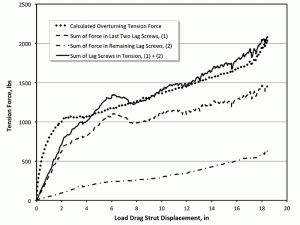
Figure 4: Lag screw forces on deck without hold-downs. (Overturning tension force calculated assuming end joist resists full overturning moment.)
Hold-Down Behavior and Geometric Effects
If the deck behaved as a rigid body, the tension chord forces could be calculated using simple statics as shown in Figure 5. However, due to the flexibility of the deck, the measured forces in the hold-down connectors were dramatically different than anticipated. The hold-down expected to resist overturning tension forces actually diminished to zero as the deck deformed. The hold-down installed on the compression chord actually had significant tension force due to a geometric prying action caused by large joist rotations (Figure 6). This geometric effect would be diminished if the deck stiffness were increased, such as by installing the decking diagonally. According to the 2008 Special Design Provisions for Wind and Seismic (AWC, 2008), shear walls and diaphragms sheathed with diagonally-oriented boards results in a four-fold increase in stiffness when compared to horizontally-oriented sheathing. Also, if the joist connections to the ledger had low withdrawal capacity, such as when nails are used in the hangers, or toe-nails, then the tension hold-down connection would be expected to function as intended.
Design Implications
Joist hangers: Joist hangers are typically rated for gravity (vertical) loads. When a deck is loaded laterally, the outermost joists are loaded in tension. Joist hangers are not load-rated in tension (i.e. joist withdrawal from the hanger). Preliminary experiments revealed that joist hangers utilizing a toe-nailed fastener orientation did not perform well when the toe-nailed connection was subject to tension loads. As such, hangers used in this project had fasteners installed perpendicular to the joist faces (Figure 7).
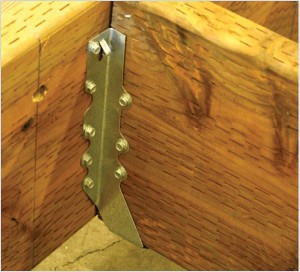
Figure 7: Deck joists had perpendicular fasteners into the joist and used joist hanger manufacturer approved screws.
Joist hanger manufacturers generally permit joist hangers to be installed with either nails or screws, as specified in appropriate technical literature. In this project, screws were used with the joist hangers to meet the provisions of IRC-2009 Section R507.1 and IBC-2009 1604.8.3, which both state that the deck attachment to an exterior wall shall not be accomplished by nails loaded in withdrawal. These provisions have been widely interpreted as applying to the deck ledger attachment; however, they should equally apply to deck joist hanger attachment to the deck ledger needed to complete the lateral load path from the deck to house.
Calculating the allowable withdrawal and lateral capacity of fastener groups (10d common nails versus #9 SST SD screws) that attach the hangers (10 fasteners into the ledger, six fasteners into the joist) determined the withdrawal design capacity for screws was 750 lb; whereas, the capacity for nails was 150 lb – a five-fold difference. One reason for the large difference is the 75% reduction in withdrawal capacity for smooth-shank nails subject to wet/dry cycling specified in Table 10.3.3 of the National Design Specification® (NDS®) for Wood Construction (AWC 2012).
Relying on any withdrawal capacity of joist hanger connections having nails subjected to tension is a potentially unsafe practice, in violation of model code provisions, and does not provide an element of structural redundancy. Some level of structural redundancy is recommended, even though in ideal laboratory conditions it was shown that sufficient withdrawal capacity could be provided by joist hanger connections when screws are used. It is important to note that both deck tests were conducted in a laboratory setting where materials were not exposed to environmental factors such as wet/dry cycles, and there was no wood decay or fastener corrosion present.
Ledger attachment: Deck ledgers were attached with 0.5-inch diameter lag screws in a staggered pattern as specified in IRC Table R502.2.2.1. The deck ledger-to-house attachment was for the conditions tested. When no tension hold-down connectors were used, the outer two lag screws carried most of the withdrawal load with no visible signs of failure (Figure 4).
Tension hold-down: The deck with tension hold-downs behaved in a counterintuitive way. The flexibility of the deck allowed significant rotation of the deck joists within the joist hangers. This resulted in a geometric “prying” effect that caused zero tension in the “tension hold-down” and significant tension in the “compression hold-down,” as shown in Figures 5 and 6. The hold-down connectors would behave in a more predictive manner if the deck lateral stiffness were increased. While hold-down devices did not appear to significantly improve deck performance in the two decks tested that utilized screws in the hangers, hold-down devices do provide some level of structural redundancy for decks in service that naturally experience different levels of deterioration or may contain installation errors such as improperly installed lag screws.
Conclusions
- The deck joist-to-ledger connection proved early on to be a weak link in the lateral load path. The problem is twofold: 1) smooth nails when loaded in withdrawal easily pull out of the deck ledger, and 2) some joist hangers use a toe-nail type of attachment of the joist to the hanger that do not engage enough of the joist, resulting in tear-out. This weak link was reinforced by using joist hanger manufacturer-approved screws and a joist hanger that had three screws on each side of the joist that were perpendicular to the joist securing the joist to the hanger.
- For two specific laboratory deck configurations that utilized screws in the deck joist hangers, no significant impact on short-term deck strength and stiffness was observed when two tension hold-downs were installed. A similar result would not be expected had nails been used in the joist hangers, since wet/dry cycling causes nails to lose 75% of withdrawal capacity.
- While the hold-down devices did not appear to significantly improve lateral-load deck performance in the two decks tested, these devices do provide a level of structural redundancy that may be needed in the event that lag screws used for the ledger connection were not properly detailed per the IRC Table R502.2.2.1 and correctly installed per the lag screw requirements of the NDS.
- Hold-downs used in lateral load deck tests exhibited significant counterintuitive behavior. This outcome was due to geometric effects caused by large lateral deck displacements and rotation of the deck joists inside the hangers.
- Testing was terminated before an ultimate strength was achieved at a load of approximately 7,000 lb for both decks. The two lag screws nearest the deck tension chord experienced the largest forces, yet did not fail in withdrawal. These results point to the effectiveness of 0.5-inch diameter lag screws when selected and installed per the IRC deck ledger connection provisions and NDS.
- The results obtained in this study generally apply to decks with an aspect ratio of 1:1 and less, where aspect ratio is defined as the deck dimension perpendicular to the house divided by the dimension parallel to the house. The study results should not be applied to decks having an aspect ratio greater than 1:1, as the failure modes and deck behavior may substantially change.
Additional research is planned to study other deck constructions and aspect ratios and to investigate other methods to achieve lateral stiffness and load capacity, and structural redundancy for new and existing decks.▪
Joist Hanger Issues
Preliminary tests using deck joist hangers that employed a double-shear (toe-nail) type of fastening to the joist did not resist joist pullout well. This is not surprising since joist hangers are optimized for resisting vertical loads rather than lateral. To overcome this weak link in the lateral resisting system, a hanger was chosen that incorporated perpendicular fasteners into the deck joist, and hanger-manufacturer approved screws were substituted for nails (Figure 7). The hanger selected was Simpson Strong-Tie (SST) Model No. LU210 (and concealed flange No. LUC210Z on the two edge joists). The LUC210Z had a “ZMAX” coating, which is classified as a medium level of corrosion resistance. At the time of the testing, the LU210 hanger was not available in the ZMAX coating. Based on the environment and materials used, the design professional should take care to specify appropriate corrosion protection for all hardware used in a deck (guidelines can be found in DCA 6).
The joist hanger manufacturer permits their hangers to be installed with either nails or screws. IRC-2009 Section R507.1 and IBC-2009 1604.8.3 both state that the deck attachment to an exterior wall shall not be accomplished by nails subject to withdrawal. These provisions have been widely interpreted as applying to the deck ledger attachment; however, they should also apply to deck joist hanger attachment to the deck ledger needed to complete the lateral load path from the deck to house. Joist hanger screws were #9 (0.131 inch diameter, 1.5 inches long) SST Structural-Connector Screws (Model No. SD9112) and #10 (0.161 inch diameter, 1.5 inches long) SST Structural-Connector Screws (Model No. SD10112). These screws have a Class 55 2006 IRC-compliant mechanical galvanized coating that is required to resist corrosion.
Acknowledgments
Donations of materials from Simpson Strong-Tie and Trex Company are gratefully acknowledged.
References
American Wood Council (AWC). 2008. Special Design Provisions for Wind and Seismic. ANSI/AF&PA SDPWS-2008, Washington, D.C.
American Wood Council (AWC). 2012. National Design Specification for Wood Construction. ANSI/AWC NDS-2012, Washington, D.C.
American Wood Council. 2001. Wood Frame Construction Manual for One- and Two-Family Dwellings. ANSI/AF&PA WFCM-2001, Washington, D.C.
Lyman, G.H. and Bender, D.A. 2013. Wind load determination for exterior decks and porches. Wood Design Focus 23(2):2-8.
Lyman, G.H., Bender, D.A., and Dolan, J.D. 2013. Seismic load determination for exterior decks and porches. Wood Design Focus 23(2):9-14.
Parsons, B.J. 2012. Understanding the lateral strength, load path, and occupant loads of exterior decks. MS Thesis, Department of Civil and Environmental Engineering, Washington State University, Pullman, WA.
Parsons, B.J., Bender, D.A., Dolan, J.D., and Woeste, F.E. 2013. Deck and porch lateral loading by occupants. Wood Design Focus 23(2):15-20.
Parsons, B.J., Bender, D.A., Dolan, J.D., Tichy, R.J., and Woeste, F.E. 2013. Lateral load path and capacity of exterior decks. Wood Design Focus 23(2):21-30.

